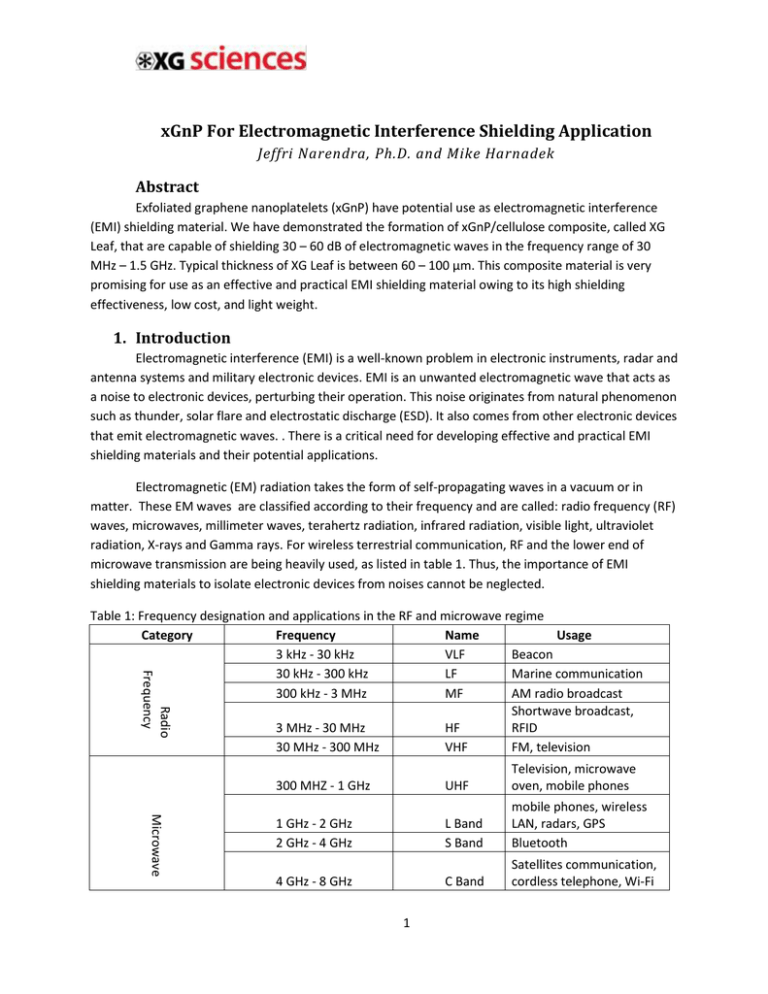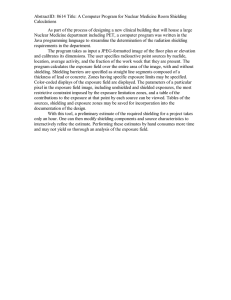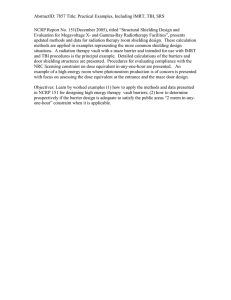xGnP For Electromagnetic Interference Shielding
advertisement

xGnP For Electromagnetic Interference Shielding Application Jeffri Narendra, Ph.D. and Mike Harnadek Abstract Exfoliated graphene nanoplatelets (xGnP) have potential use as electromagnetic interference (EMI) shielding material. We have demonstrated the formation of xGnP/cellulose composite, called XG Leaf, that are capable of shielding 30 – 60 dB of electromagnetic waves in the frequency range of 30 MHz – 1.5 GHz. Typical thickness of XG Leaf is between 60 – 100 µm. This composite material is very promising for use as an effective and practical EMI shielding material owing to its high shielding effectiveness, low cost, and light weight. 1. Introduction Electromagnetic interference (EMI) is a well-known problem in electronic instruments, radar and antenna systems and military electronic devices. EMI is an unwanted electromagnetic wave that acts as a noise to electronic devices, perturbing their operation. This noise originates from natural phenomenon such as thunder, solar flare and electrostatic discharge (ESD). It also comes from other electronic devices that emit electromagnetic waves. . There is a critical need for developing effective and practical EMI shielding materials and their potential applications. Electromagnetic (EM) radiation takes the form of self-propagating waves in a vacuum or in matter. These EM waves are classified according to their frequency and are called: radio frequency (RF) waves, microwaves, millimeter waves, terahertz radiation, infrared radiation, visible light, ultraviolet radiation, X-rays and Gamma rays. For wireless terrestrial communication, RF and the lower end of microwave transmission are being heavily used, as listed in table 1. Thus, the importance of EMI shielding materials to isolate electronic devices from noises cannot be neglected. Radio Frequency Table 1: Frequency designation and applications in the RF and microwave regime Category Frequency Name Usage 3 kHz - 30 kHz VLF Beacon 30 kHz - 300 kHz LF Marine communication 300 kHz - 3 MHz MF AM radio broadcast Shortwave broadcast, 3 MHz - 30 MHz HF RFID 30 MHz - 300 MHz VHF FM, television UHF Television, microwave oven, mobile phones 1 GHz - 2 GHz 2 GHz - 4 GHz L Band S Band mobile phones, wireless LAN, radars, GPS Bluetooth 4 GHz - 8 GHz C Band Satellites communication, cordless telephone, Wi-Fi 300 MHZ - 1 GHz Microwave 1 8 GHz - 12 GHz 12 GHz - 18 GHz 18 GHz - 27 GHz 27 GHz - 40 GHz 40 GHz - 75 GHz 75 GHz - 110 GHz X Band Ku Band K Band Ka Band V Band W Band Satellites communication Satellites communication Satellites communication Satellites communication military and research military and research Shielding of EM waves lower than the infrared radiation can be accomplished using a Faraday Cage, an enclosure formed by electrically conducting material or by a mesh of such material. External electrical charges are redistributed by the conductive surfaces of the cage, cancelling out the effects of the field as illustrated in figure 1. Shield Shield Noise source No internal field Noise source No external field (A) (B) Figure 1: Illustration of a Faraday Cage used for: (A) shielding a device from outside noise, and (B) shielding noise generated from a device. For EMI shielding, the device should be thoroughly covered by conductive materials (copper foil, aluminum foil, steel, etc.); but depending on the shielding regulations for each device, some gaps can be allowed. The shielding effectiveness is varied by the amount of the transmittance of EMI depending on the conductivity and thickness of the material; and frequency and strength of electromagnetic energy. Metals are well suited for many EMI shielding applications. However, metals have their own shortcomings like weight, susceptibility to corrosion, wear, and physical rigidity. The conductive particle filled polymer-matrix composites have advantages like low weight, resistance to corrosion, ease of processing and tailored coefficient of thermal expansion. In particular, polymer composites containing carbon-based fillers (e.g., graphite, carbon black, carbon fibers, carbon nanofibers, carbon nanotubes) have been extensively investigated for use as EMI shielding owing to their unique combination of electrical conduction, flexibility, and light weight. The electrical conductivity is imparted to the composite due to the formation of 3-dimensional (3-D) conducting paths of fillers within the matrix. The minimum loading of conducting particles at and above which 3-D network is formed within the matrix is called a percolation threshold. The percolation 2 threshold depends upon the aspect ratio, inherent electrical conductivity and degree of dispersion of filler in the matrix, nature of interface and interaction between the filler and matrix. Carbon nanofibers, nanotubes, and exfoliated graphene nanoplatelets (xGnP), as compared to conventional carbon fillers, have outstanding structural, mechanical, and electrical properties, such as smaller diameters, larger aspect ratios, much higher conductivities and strengths. The use of these carbon nanostructures as fillers in the polymeric composites allows systems with lower filler loadings to provide the desired electrical and EMI shielding properties. Attenuation is one of the principal indicators for measuring the effectiveness of electromagnetic interference shielding. It refers to the difference between an electromagnetic signal’s intensity before and after shielding. Attenuation is marked in decibels (dB) that correspond to the ratio between field strength with and without the presence of a protective medium. The decrease in a signal’s intensity, or amplitude, is usually exponential with distance, while the decibel range falls along a logarithmic scale. This means that an attenuation rating of 50 dB indicates a shielding strength ten times that of 40 dB. In general, a shielding range of 10 to 30 dB provides the lowest effective level of shielding, while anything below that range can be considered little or no shielding. Shielding between 60 and 90 dB may be considered a high level of protection, while 90 to 120 dB is exceptional. Products in the market: Acheson Chomerics Creative Materials Spraylat Randolf 2. Brief Review on Electromagnetic Waves The Electromagnetic wave has a frequency that corresponds to the wavelength (λ) according to the following relation: where ν is the velocity of the wave and f is the frequency. In free space, ν = 1/√(µ0ϵ0) = c = 2.998x108 m/s, which is the speed of light. Notation µ0 and ϵ0 correspond to free space permeability (4πx10-7 H/m) and permittivity (8.85x10-12 F/m), respectively. In a specific medium, the permeability and permittivity can be defined by using their relative characteristics: In general, there are three types of mediums: lossless, lossy, and good conductors, according to their permeability, permittivity, and conductivity (σ). Electromagnetic wave can propagate through these medium with propagation constant (γ) defined as: √ √ 3 where ω is the angular frequency (ω = 2πf) and tanδ is the loss tangent, defined as: where ϵ’ and ϵ” are the real and imaginary part of the material permittivity. Material can be considered as lossless when the imaginary part of the permittivity and the conductivity are zero. A good conductor, on the other hand, has high conductivity or the imaginary part of the permittivity (ϵ”>>ϵ’ or σ >>ωϵ’). The loss tangent term arise from the attenuation of the wave energy due to damping of the vibrating dipole moment resulting in heat generation. Consider a simple case of two free space regions divided by a medium as illustrated in figure 2. When the electromagnetic wave hits the material, it is transformed to a reflected wave, an infiltrated wave, and a transmitted wave. If the medium is lossless, the infiltrated wave would have a different wavelength, but the incident wave would equal to the transmitted wave. In the case of a perfect electric conductor (PEC), which has infinite electrical conductivity, the incident wave would equal to the reflected wave. For lossy materials, the infiltrated wave is attenuated. Figure 2: Illustration of wave propagation through a medium. To describe the transmission behavior of a wave from region 1 to region 2, the scattering matrix or S-parameter can be employed. In particular, the merit of a shielding medium to reduce the power of the transmitted wave with respect to the incident wave can be found by measuring the transmission coefficient (S21) of the S-parameter. In practice, most metals are categorized as good conductors but not perfectly electrically conductive. EM propagation through a good conductor also suffers some attenuation. The waves would penetrate the good conductor medium at certain depth, but the amplitude of the fields decay. A skin depth (δs) can be defined as the depth of penetration where the amplitude becomes 1/e of the incident wave: 4 √ The relationship between skin depth of some common good conductor and the frequency is shown in figure 3. It can be seen that waves with lower frequency penetrate deeper into the good conducting medium. Therefore, material thickness plays a big role in shielding lower the frequency of the EM wave. For a high frequency wave, the skin effect would be the dominant factor. In this case, higher surface conductivity would increase the shielding efficiency. Figure 3: Skin depth of some common metals at various frequencies. Some EMI Shielding materials have perforations in the shape of small holes lined up in arrays. If the frequency of the incident wave is higher than the cut-off frequency, which is defined by the size of the opening, the wave can go through. However, for any EM waves below the cut-off frequency, the wave will be attenuated. 3. Experimental For the EMI SE measurements, a variety of xGnP grades were used as fillers in XG Leaf , a paper composite, in which the base fiber is cellulose and the method of production is similar to paper making. For this experiment, the targeted EMI shielding efficiency is between 30 – 60 dB, using materials that are less than 100 µm in thickness. A variety of xGnP grades with various loading percentages were produced and measured. Additionally, perforated shielding materials based on XG Leaf were studied. Eight (8) samples of xGnP/cellulose fiber (xG Paper) have been prepared by cutting two 12x12 (in inches) XG Leaf. Sample parameters: 5 - 6 grams filler 248 grams of 2% pH adjusted M25 slurry from production line 45/55 graphene/cellulose pH: 7 – 8 All samples were pressed individually using Pasadena Hydraulic, Inc to 40,000 ram force in pounds for one minute. Sample S1 and S3 were perforated using a leather belt puncher with diameter opening of 5 mm and 2 mm, respectively. The separation distance between holes was set to 1 cm. apart, measured from the center of each holes, for both samples. S4 was perforated using a porcupine roller and S6 was folded several times in different directions to observe the effect of creases on the paper (Surface roughness) to the EMI SE performance. A photographic image of the samples is shown in figure 4. After performing the perforation, the samples no longer have smooth surfaces. Therefore, the samples were compressed again. Measurements were taken before and after re-compression S6 Control S4 S1 S3 Figure 4: Photographic image of XG Leaf prepared in various perforations. The EMI shielding effectiveness of the samples was measured according to ASTM D4953 standard. The test setup, shown in Figure 5, consisted of a EM-2107A standard specimen holder, which was connected to a Hewlett-Packard (HP) 8753D vector network analyzer via coaxial cable with N-type connectors. An N-type calibration kit was used to calibrate the system. Standard attenuator with total attenuation of 100 decibels (dB) was tested to ensure that all sample measurements were valid up to 6 100 dB. The frequency is scanned from 30 MHz to 1.5 GHz with 401 data point. The transmission coefficients of the S-parameter for five frequencies (30 MHz, 100 MHz, 500 MHz, 1 GHz, and 1.5 GHz) were plotted. Shielding efficiency was calculated from the difference between transmission of load sample and reference sample. Drawing of both samples is shown on figure 6. Coaxial cable Test fixture Vector Network Analyzer Sample Figure 5: Set up for EMI shielding effectiveness measurement Figure 6: Drawing of the reference sample and load sample for shielding efficiency measurement. 7 4. Result and discussion Figures 7 – 11 show the results of EMI shielding measurements of various XG Leaf samples. In general, the shielding effectiveness increases when the frequency of the EMI is increases. This phenomenon is related to the skin depth of the waves. Shielding Efficiency [dB] Thickness (stacked) 100.0 90.0 80.0 70.0 60.0 50.0 40.0 30.0 20.0 L30×10 L30×9 L30×8 L30×7 L30×6 L30×5 L30×4 10.0 0.0 L30×3 0.0 500.0 1000.0 Frequency [MHz] 1500.0 L30×2 L30×1 Figure 7: Thickness of each sheet is 62 microns. Number following “L-30×” represents the number of sheets of XG Leaf in the stack. Composition: 65% H-50 / 35% Copy paper. The relationship of thickness to shielding efficiency was explored by stacking multiple sheets prepared from a single batch, as seen in figure 7. The greater the total thickness of the stack was, the greater the shielding efficiency. Within the frequency of interest, changing the thickness of the shielding material by an order of magnitude would double the shielding efficiency. 8 Density and Platelet Size 50.0 45.0 Shielding Efficiency [dB] 40.0 H-50 Compressed 0.98 g/cc H-5 Compressed 0.96 g/cc H-50 Uncompressed 0.13 g/cc H-5 Uncompressed 0.24 g/cc 35.0 30.0 25.0 20.0 15.0 10.0 5.0 0.0 0.0 500.0 1000.0 Frequency [MH] 1500.0 Figure 8: Thicknesses are: H-50 Compressed = 55 μm; H-50 Uncompressed = 422 μm; H-5 Compressed = 57 μm; H-5 Uncompressed = 254 μm An XG Leaf of 65% H-50 and an XG Leaf of 65% H-5 were prepared. Measurements were made before and after the compression process. Higher density results in higher shielding efficiency, as shown in figure 8. Also, when densities are similar, larger platelets produce greater shielding efficiency. Loading Shielding Efficiency [dB] 60.0 50.0 40.0 80% 65% 30.0 50% 20.0 40% 10.0 30% 0.0 0.0 500.0 1000.0 1500.0 Frequency [MHz] Figure 9: Percent by weight of xGnP H-50 in cellulose. Conditions: compressed; typical thickness =85 microns; typical density = 0.86 g/cc. 9 In figure 9, XG Leaf with various loadings of H-50 but similar thicknesses and densities were prepared and measured. As ratio of xGnP to cellulose increased, the shielding efficiency increased. Shielding Efficiency [dB] Cellulose Leaf EMI Shielding 50.000 45.000 40.000 35.000 30.000 25.000 20.000 15.000 10.000 5.000 0.000 0.000 65% H-50 65% M-45 65% T-50 65% C-300 500.000 1000.000 1500.000 Frequency [MHz] Figure 10: Comparison of xGnP grades. Four grades of xGnP were compared when used for XG Leaf formation. While there was almost no difference between H- and M-grades, there was a small drop in shielding efficiency for T-grade. However, C-300 materials did not performed well for shielding applications. Perforating the shielding material would lower its shielding efficiency as shown on figure 11. The bigger the size of the opening would lower the shielding efficiency, especially for the shorter wavelength or higher frequency. It should also be noted that the re-compressed XG leaf samples that have smoother surface regain their shielding efficiency. Thus, surface roughness has effect on EMI shielding. 10 Effect of Opening Sizes on the Perforated XG Leaf 35 Shielding Efficiency [dB] 33 31 29 No Perforation 27 Roller(Sample4) 25 2mm hole 23 21 5mm hole 19 2mm hole re-pressed 17 5mm hole re-pressed 15 0 500 1000 1500 Frequency [Hz] Figure 11: Comparison of perforated XG Leaf with different opening sizes. 11


